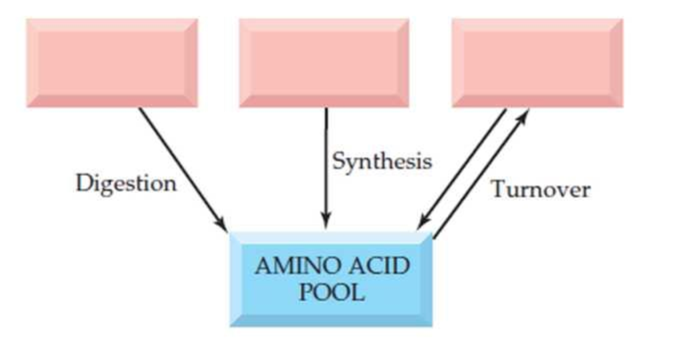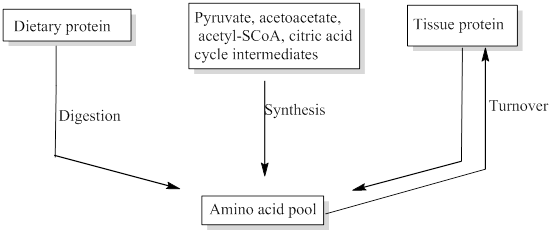
Fundamentals of General, Organic, and Biological Chemistry, Books a la Carte Plus Mastering Chemistry with Pearson eText -- Access Card Package (8th Edition)
8th Edition
ISBN: 9780134261256
Author: John McMurray, David S. Ballantine, Carl A. Hoeger, Virginia E. Peterson
Publisher: PEARSON
expand_more
expand_more
format_list_bulleted
Concept explainers
Textbook Question
Chapter 25, Problem 25.11UKC
In the diagram shown here, fill in the sources for the amino acid pool.

Expert Solution & Answer
Interpretation Introduction
Interpretation:
The missing sources for the amino acids pool has to be filled.
Concept introduction:
- Amino acid had both amino functional group and carboxyl functional group in a molecule.
- Amino acid pool is the entire collection of free amino acids in the whole body.
Explanation of Solution
Free amino acids are present throughout the body, in cells and the extracellular fluids. This pool is supplied by few sources include,
- Non-protein nitrogen compounds
- Dietary protein
- Tissue protein etc.

Conclusion
The missing sources for the amino acids pool was filled.
Want to see more full solutions like this?
Subscribe now to access step-by-step solutions to millions of textbook problems written by subject matter experts!
Students have asked these similar questions
Can koch's postulates of disease causation be applied to non-microorganism disease pathogens (such as molecules)?
Here is my literature Beta Carotene HPLC analysis graph.
Can you help me explain what each peak is at each retention time?
Thank You :D
I have a literature B-Carotene HPLC graph in which showcases a retention time of roughly 23.6 and 25.1.
Please help me compare my two different Anti-Oxidant Juice graphs. (Attached)
The juices provided are: V8 Carrot Ginger Blend and V8 Original Blend
Noticing the HPLC graphs I saw no peaks for the Original Blend for B-Carotene.
However the Carrot Ginger Blend showed similar peaks --> Why is this reason?
Please explain in terms of Retention time and Area (Under Curve).
Thank You!
Chapter 25 Solutions
Fundamentals of General, Organic, and Biological Chemistry, Books a la Carte Plus Mastering Chemistry with Pearson eText -- Access Card Package (8th Edition)
Ch. 25.2 - Prob. 25.1PCh. 25.2 - Prob. 25.2KCPCh. 25.3 - Prob. 25.3PCh. 25.3 - Prob. 25.4PCh. 25.3 - Prob. 25.5PCh. 25.3 - Prob. 25.6PCh. 25.4 - Prob. 25.1CIAPCh. 25.4 - Prob. 25.2CIAPCh. 25.4 - Prob. 25.3CIAPCh. 25.4 - Prob. 25.7P
Ch. 25.4 - Prob. 25.8KCPCh. 25.6 - Prob. 25.9PCh. 25.6 - Prob. 25.10KCPCh. 25.6 - What is meant by a conditional amino acid?Ch. 25.6 - Prob. 25.5CIAPCh. 25.6 - Prob. 25.6CIAPCh. 25 - In the diagram shown here, fill in the sources for...Ch. 25 - Prob. 25.12UKCCh. 25 - Prob. 25.13UKCCh. 25 - Prob. 25.14UKCCh. 25 - Prob. 25.15UKCCh. 25 - Prob. 25.16UKCCh. 25 - Prob. 25.17APCh. 25 - Prob. 25.18APCh. 25 - Prob. 25.19APCh. 25 - Prob. 25.20APCh. 25 - Prob. 25.21APCh. 25 - Prob. 25.22APCh. 25 - What is the structure of the -keto acid formed...Ch. 25 - Prob. 25.24APCh. 25 - In general, how does oxidative deamination differ...Ch. 25 - Prob. 25.26APCh. 25 - Prob. 25.27APCh. 25 - Prob. 25.28APCh. 25 - Prob. 25.29APCh. 25 - Prob. 25.30APCh. 25 - Prob. 25.31APCh. 25 - Prob. 25.32APCh. 25 - Prob. 25.33APCh. 25 - Prob. 25.34APCh. 25 - How do essential and nonessential amino acids...Ch. 25 - Prob. 25.36APCh. 25 - Prob. 25.37APCh. 25 - How is tyrosine biosynthesized in the body? What...Ch. 25 - Prob. 25.39APCh. 25 - Prob. 25.40APCh. 25 - Prob. 25.41APCh. 25 - What energy source is used in the formation of...Ch. 25 - Write the equation for the transamination reaction...Ch. 25 - Prob. 25.44CPCh. 25 - Prob. 25.45CPCh. 25 - Prob. 25.46CPCh. 25 - Prob. 25.47CPCh. 25 - Prob. 25.48CPCh. 25 - Prob. 25.49CPCh. 25 - Prob. 25.50CPCh. 25 - Prob. 25.51CPCh. 25 - Prob. 25.52CPCh. 25 - Why might it be a bad idea to take large...Ch. 25 - Prob. 25.54GPCh. 25 - Prob. 25.55GPCh. 25 - Prob. 25.56GP
Additional Science Textbook Solutions
Find more solutions based on key concepts
Give the IUPAC name for each compound.
Organic Chemistry
What process causes the Mediterranean intermediate Water MIW to become more dense than water in the adjacent At...
Applications and Investigations in Earth Science (9th Edition)
Why do scientists think that all forms of life on earth have a common origin?
Genetics: From Genes to Genomes
Separate the list P,F,V,,T,a,m,L,t, and V into intensive properties, extensive properties, and nonproperties.
Fundamentals Of Thermodynamics
Identify each of the following reproductive barriers as prezygotic or postzygotic. a. One lilac species lives o...
Campbell Essential Biology with Physiology (5th Edition)
Knowledge Booster
Learn more about
Need a deep-dive on the concept behind this application? Look no further. Learn more about this topic, biochemistry and related others by exploring similar questions and additional content below.Similar questions
- Calculate pH of a solution prepared by dissolving 1.60g of sodium acetate, in 88.5 mL of 0.10 M acetic acid. Assume the volume change upon dissolving the sodium acetate is negligible. Ka is 1.75 x 10^-5arrow_forwardShow a mechanism that leads to the opening of the ring below under acid-catalyzed conditions. Give the correct Fischer projection for this sugar.arrow_forwardWhat is the stereochemical relationship between B & C?arrow_forward
- Don't use ai or any chat gpt will dislike okk just use accurate information okkk okkk just solve full accurate. don't use guidelines okk just did it accurate 100% sure experts solve it correct complete solutions okkk follow all instructions requirements okkkarrow_forwardhow would you make this plot in excel?arrow_forwardwhat is the productarrow_forward
- Balance the following equation and list of coefficients in order from left to right. SF4+H2O+—-> H2SO3+HFarrow_forwardProblem 15 of 15 Submit Using the following reaction data points, construct Lineweaver-Burk plots for an enzyme with and without an inhibitor by dragging the points to their relevant coordinates on the graph and drawing a line of best fit. Using the information from this plot, determine the type of inhibitor present. 1 mM-1 1 s mM -1 [S]' V' with 10 μg per 20 54 10 36 20 5 27 2.5 23 1.25 20 Answer: |||arrow_forward12:33 CO Problem 4 of 15 4G 54% Done On the following Lineweaver-Burk -1 plot, identify the by dragging the Km point to the appropriate value. 1/V 40 35- 30- 25 20 15 10- T Км -15 10 -5 0 5 ||| 10 15 №20 25 25 30 1/[S] Г powered by desmosarrow_forward
arrow_back_ios
SEE MORE QUESTIONS
arrow_forward_ios
Recommended textbooks for you
 Human Biology (MindTap Course List)BiologyISBN:9781305112100Author:Cecie Starr, Beverly McMillanPublisher:Cengage Learning
Human Biology (MindTap Course List)BiologyISBN:9781305112100Author:Cecie Starr, Beverly McMillanPublisher:Cengage Learning Human Heredity: Principles and Issues (MindTap Co...BiologyISBN:9781305251052Author:Michael CummingsPublisher:Cengage Learning
Human Heredity: Principles and Issues (MindTap Co...BiologyISBN:9781305251052Author:Michael CummingsPublisher:Cengage Learning Biology (MindTap Course List)BiologyISBN:9781337392938Author:Eldra Solomon, Charles Martin, Diana W. Martin, Linda R. BergPublisher:Cengage Learning
Biology (MindTap Course List)BiologyISBN:9781337392938Author:Eldra Solomon, Charles Martin, Diana W. Martin, Linda R. BergPublisher:Cengage Learning
 Human Physiology: From Cells to Systems (MindTap ...BiologyISBN:9781285866932Author:Lauralee SherwoodPublisher:Cengage Learning
Human Physiology: From Cells to Systems (MindTap ...BiologyISBN:9781285866932Author:Lauralee SherwoodPublisher:Cengage Learning


Human Biology (MindTap Course List)
Biology
ISBN:9781305112100
Author:Cecie Starr, Beverly McMillan
Publisher:Cengage Learning

Human Heredity: Principles and Issues (MindTap Co...
Biology
ISBN:9781305251052
Author:Michael Cummings
Publisher:Cengage Learning

Biology (MindTap Course List)
Biology
ISBN:9781337392938
Author:Eldra Solomon, Charles Martin, Diana W. Martin, Linda R. Berg
Publisher:Cengage Learning


Human Physiology: From Cells to Systems (MindTap ...
Biology
ISBN:9781285866932
Author:Lauralee Sherwood
Publisher:Cengage Learning
The Cell Membrane; Author: The Organic Chemistry Tutor;https://www.youtube.com/watch?v=AsffT7XIXbA;License: Standard youtube license